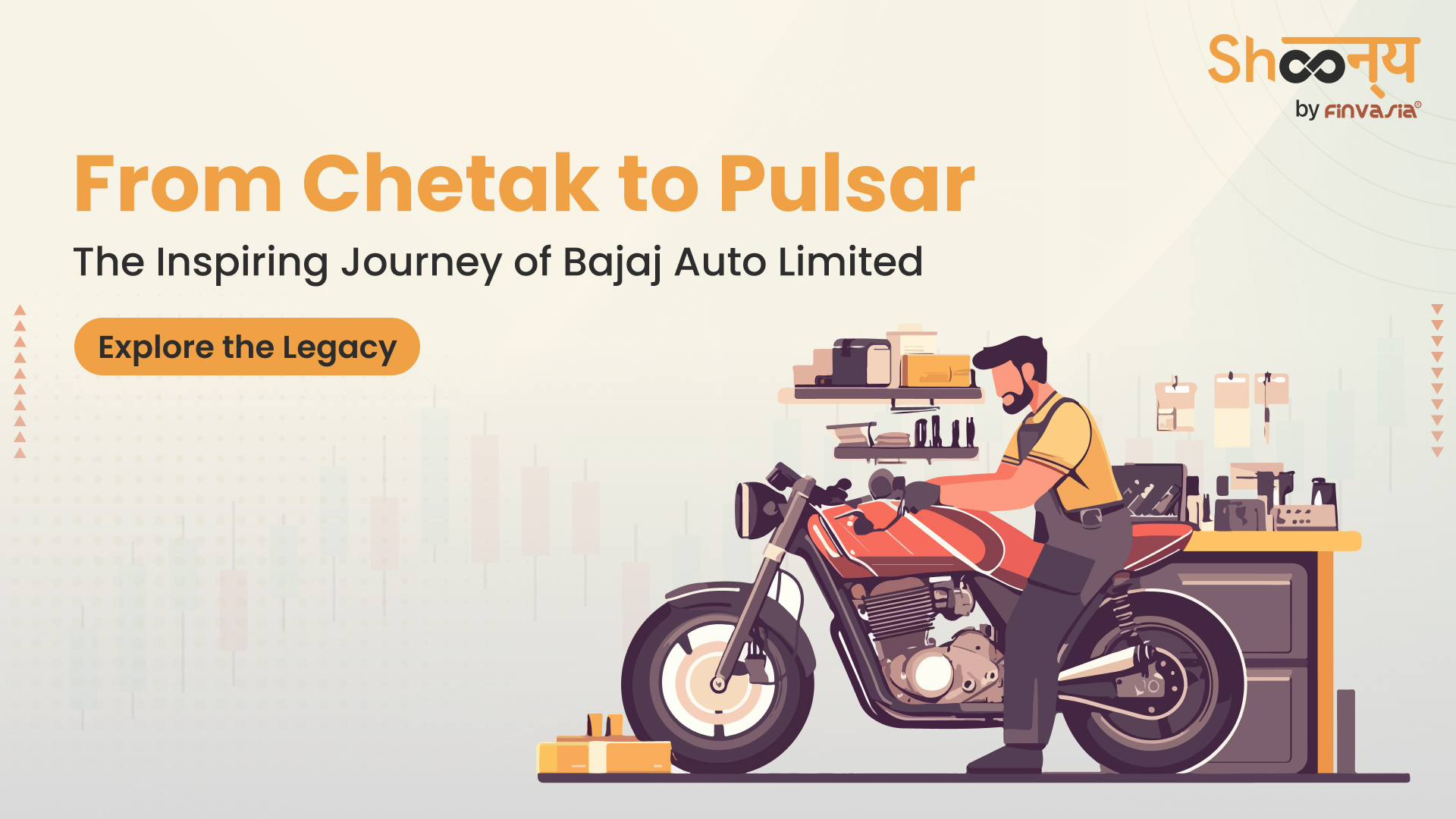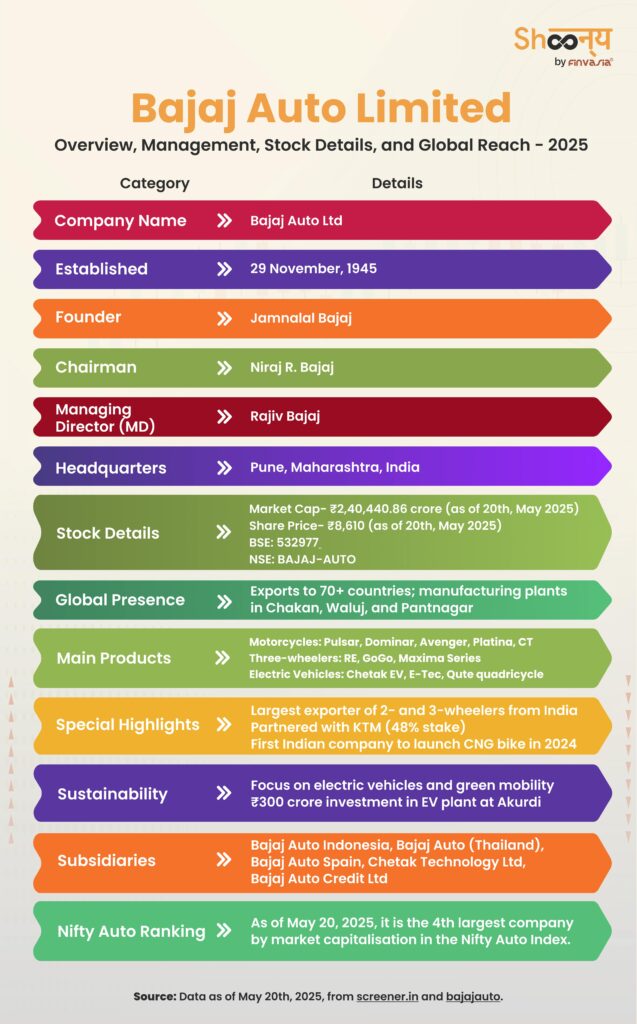How Bajaj Auto Ltd Rolled into the Global Market from Indian Streets

We all have fond childhood memories of riding with our father or brother on a Bajaj Chetak. That gentle hum of the scooter, the breeze on our faces, and the fun all wrapped into one. For many Indian families, Bajaj Chetak was part of growing up. But did you know that this iconic scooter was made by Bajaj Auto Limited?
The story began way back in 1945 when Jamnalal Bajaj laid the foundation of the Bajaj Group. From those humble beginnings, From those early days, Bajaj Auto has grown into one of India’s biggest and most trusted vehicle makers.
Let’s walk down memory lane and explore the real history of Bajaj Auto Ltd.
Founded even before India’s independence, the company has come a long way. Today, it proudly stands as the fourth-largest company in the Nifty Auto Index with a market capitalisation of ₹2,38,284.98 crore (as of May 20th, 2025).

Want to invest in Bajaj Auto stock?
Start with a free Demat account – quick, easy, and zero charges!
Bajaj Auto Through the Decades: A Look Back
Bajaj Auto’s journey began in 1945 when a Gandhian family started M/s Bachhraj Trading Corporation Private Limited.
This was the beginning of a company that would soon become a household name in India’s two- and three-wheeler industry.
Just a few years later, in 1959, Bajaj Auto got its license from the Government of India to start manufacturing its own vehicles. It was truly the first “Make in India” effort in this space.
The 1960s brought some great developments.
Bajaj launched the Vespa 150 under license from Italy’s Piaggio, and this scooter quickly became a favourite for its style and performance. That same decade, Bajaj Auto went public and built its first manufacturing plant in Akurdi.
By the early 1970s, Bajaj Auto was shaping the way India moved.
The launch of the original Chetak scooter in 1972 became legendary. It was a symbol of independence and personal mobility for millions of Indians.
Around the same time, Bajaj introduced its first three-wheeler goods carrier, supporting small businesses and entrepreneurs across the country.
The late 1970s saw Bajaj Auto’s three-wheeler autorickshaw. The Bajaj RE become an iconic sight on Indian roads.
Alongside this, the Bajaj Priya scooter came out with a powerful 150cc engine and stylish design. It quickly becoming a crowd favourite.
The 1980s marked another era of growth.
Bajaj partnered with Kawasaki to launch the KB100, which soon became a legendary bike for its performance.
A new manufacturing plant at Waluj was inaugurated in record time.
Bajaj also introduced the M50, a step-through bike loved by suburban and rural buyers for its fuel efficiency and affordability.
By the end of the decade, Bajaj’s ‘Hamara Bajaj’ campaign captured the nation’s imagination, turning the Bajaj scooter into a symbol of Indian pride and progress.
The 1990s brought more innovation.
Bajaj launched the Sunny, a bike that became an instant hit among college students for its speed and style.
The Kawasaki Bajaj 4S Champion followed, popular with daily commuters. Bajaj also expanded production with a new plant in Chakan and introduced the Caliber motorcycle, which hit 100,000 sales within just a year. The rugged Bajaj Boxer, launched in 1997, became hugely popular in markets like Africa for its durability and value.
A big moment came in 2001 when Bajaj launched the Pulsar, a bike that redefined sports biking in India. The Pulsar quickly built a passionate fanbase called “Pulsarmaniacs” and changed the way people saw motorcycles in India. This success continued with the launch of the Pulsar 220 in 2009, a bike loved by young riders for its speed and style.
The 2000s also marked Bajaj’s global ambitions.
The company began large-scale exports, starting with Mexico, and eventually reaching over 70 countries. Bajaj also entered a partnership with Austrian motorcycle brand KTM in 2007, bringing world-class racing bikes to India.
The same year, a new plant in Pantnagar, Uttarakhand, was opened, expanding Bajaj’s production capacity outside Maharashtra.
In the 2010s, Bajaj continued to innovate and diversify. The first made-in-India KTMs, like the Duke 125 and Duke 250, hit the roads.
Bajaj also launched the Pulsar RS200, the fastest in the Pulsar family, and introduced the Qute quadricycle in 2015, India’s first low-cost, last-mile transport solution. The Dominar 400, launched in 2016, became Bajaj’s most powerful motorcycle, and the special Bajaj V model paid tribute to the Indian armed forces with metal from the INS Vikrant warship.
The late 2010s were marked by Bajaj’s push into electric vehicles and new markets. The iconic Chetak scooter was reborn in 2019 as a stylish electric ride, sparking excitement with the Chetak Yatra, a 70,000 km journey across India.
That year, the Pulsar 125 arrived, bringing the Pulsar thrill to more affordable bikes and becoming the fastest-selling Pulsar ever. Bajaj also became India’s biggest exporter of two- and three-wheelers, proudly calling itself “The World’s Favourite Indian.”
Recently, Bajaj Auto has doubled down on the future of electric vehicles. In 2022, it announced a ₹300 crore investment in a new plant at Akurdi to manufacture 5 lakh electric vehicles every year.
In 2023–24, Bajaj Auto saw strong growth with record revenues and profits. The company expanded its electric vehicle lineup, especially with the Chetak EV and new electric 3-wheelers.
It also announced the world’s first CNG bike, launching in July 2024. Despite export challenges, it gained momentum in regions like Latin America and MENA.
About Bajaj Auto Limited: Share Price, History, Products & More
Bajaj Auto Limited is a well-known Indian multinational company based in Pune, Maharashtra. Over the years, it has become one of India’s top manufacturers of motorcycles, scooters, and three-wheelers.
Bajaj Auto Global Presence
Bajaj Auto has three main manufacturing plants in India located in Chakan (Pune), Waluj (Aurangabad), and Pantnagar (Uttarakhand).
Together, these plants can produce over 7 million vehicles every year. The company exports its vehicles to over 70 countries, making it India’s largest exporter of motorcycles, three-wheelers, and quadricycles.
Curious about Bajaj Finance vs Bajaj Finserv? Learn the difference today!
Bajaj Auto Products
- Motorcycles: Bajaj’s popular motorcycles include models like Pulsar, Dominar, Avenger, and Platina. The Pulsar series, launched in 2001, has been very successful with over 10 million units sold by 2018.
- Three-Wheelers: Bajaj is the world’s largest maker of auto rickshaws, holding nearly 84% of India’s three-wheeler exports.
- Electric Vehicles: Bajaj entered the electric vehicle market in 2020 with the launch of the Chetak Electric scooter. The company invested ₹300 crore to set up a production facility in Pune with an annual capacity of 500,000 electric vehicles.
Bajaj Auto Sustainability and CSR
Bajaj Auto focuses on sustainable mobility and corporate social responsibility. The company invests in electric vehicle technology and supports education, healthcare, and skill development programs.
Bajaj Auto becoming a public limited company in 1960 and rolling out its 100,000th vehicle in 1970.
Popular Bikes:
- Pulsar series (like Pulsar NS400 and NS200)
- Dominar
- Avenger
- Platina
- CT
Three-Wheelers & Qute:
- GoGo
- E-Tec
- RE
- Maxima series
- Qute (small four-wheeler)
Bajaj Auto Subsidiaries
- PT. Bajaj Auto Indonesia
This is Bajaj Auto’s company in Indonesia. Bajaj owns almost all of it (99.25%). It handles trading, importing, and exporting Bajaj’s two-wheelers and three-wheelers in Indonesia.
- Bajaj Auto International Holdings BV, Netherlands
This company is fully owned by Bajaj Auto and is based in the Netherlands. Its main job is investment. Through this company, Bajaj has invested a large amount (about ₹1,219 crore) in KTM Group, an Austrian motorcycle company.
- Bajaj Auto (Thailand) Limited
This is Bajaj’s company in Thailand, fully owned by Bajaj Auto. It has set up an International Business Centre and an Engineering Design Centre there. The company was started with capital of around ₹11 crore.
- Bajaj Auto Spain, S.L.
This is Bajaj Auto’s 100% owned company in Barcelona, Spain. It has a Design Studio/office to work on new vehicle designs.
- Chetak Technology Limited
This is a wholly owned subsidiary focusing on new and growing areas like electric and hybrid vehicles. It plans to make electric and hybrid two-wheelers, three-wheelers, and small four-wheelers.
- Bajaj Auto Credit Limited
This company is Bajaj’s own finance company, created to provide loans and finance for Bajaj’s vehicles. It started in December 2021 with the name Bajaj Auto Consumer Finance Limited and was renamed Bajaj Auto Credit Limited in December 2023. It is registered with the Reserve Bank of India (RBI) to work as a Non-Banking Finance Company (NBFC).
Bajaj Auto Ltd continues to ride strong on the back of innovation, global expansion, and a solid legacy in India.
Bajaj Auto Limited- FAQs
Bajaj Auto Ltd is a publicly listed private company, not owned by the government. It is listed on the NSE and BSE.
Bajaj Auto makes motorcycles, scooters, three-wheelers (auto-rickshaws), and electric vehicles under brands like Pulsar, Dominar, Chetak, and RE.
The company is part of the Bajaj Group, founded by Jamnalal Bajaj, and is currently promoted by the Bajaj family. Niraj R. Bajaj is the Chairman.
The current share price of Bajaj Auto is ₹8,610 (as of May 20, 2025).
Bajaj Auto is the 4th largest company among the top constituents of the Nifty Auto Index based on the market cap of ₹2,40,440.86 crore as of May 20, 2025.
Bajaj Auto owns about 48% stake in KTM AG, an Austrian bike manufacturer, making it a significant partner but not a full owner.
Yes, Bajaj Auto is a multinational company, exporting to over 70+ countries, especially in Africa, Latin America, and South Asia.
As of 2025, Sanjiv Bajaj is the Chairman & Managing Director of Bajaj Finserv, and Rajeev Jain is the CEO & MD of Bajaj Finance Ltd.
______________________________________________________________________________________
Disclaimer: Investments in the securities market are subject to market risks; read all the related documents carefully before investing.








